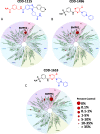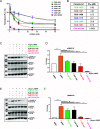Discovery of Highly Potent and BMPR2-Selective Kinase Inhibitors Using DNA-Encoded Chemical Library Screening
- PMID: 36719862
- PMCID: PMC9924264
- DOI: 10.1021/acs.jmedchem.2c01886
Discovery of Highly Potent and BMPR2-Selective Kinase Inhibitors Using DNA-Encoded Chemical Library Screening
Abstract
The discovery of monokinase-selective inhibitors for patients is challenging because the 500+ kinases encoded by the human genome share highly conserved catalytic domains. Until now, no selective inhibitors unique for a single transforming growth factor β (TGFβ) family transmembrane receptor kinase, including bone morphogenetic protein receptor type 2 (BMPR2), have been reported. This dearth of receptor-specific kinase inhibitors hinders therapeutic options for skeletal defects and cancer as a result of an overactivated BMP signaling pathway. By screening 4.17 billion "unbiased" and "kinase-biased" DNA-encoded chemical library molecules, we identified hits CDD-1115 and CDD-1431, respectively, that were low-nanomolar selective kinase inhibitors of BMPR2. Structure-activity relationship studies addressed metabolic lability and high-molecular-weight issues, resulting in potent and BMPR2-selective inhibitor analogs CDD-1281 (IC50 = 1.2 nM) and CDD-1653 (IC50 = 2.8 nM), respectively. Our work demonstrates that DNA-encoded chemistry technology (DEC-Tec) is reliable for identifying novel first-in-class, highly potent, and selective kinase inhibitors.
Conflict of interest statement
The authors declare no competing financial interest.
Figures





Similar articles
-
Activins bind and signal via bone morphogenetic protein receptor type II (BMPR2) in immortalized gonadotrope-like cells.Cell Signal. 2013 Dec;25(12):2717-26. doi: 10.1016/j.cellsig.2013.09.002. Epub 2013 Sep 7. Cell Signal. 2013. PMID: 24018044
-
Clinical significance linked to functional defects in bone morphogenetic protein type 2 receptor, BMPR2.BMB Rep. 2017 Jun;50(6):308-317. doi: 10.5483/bmbrep.2017.50.6.059. BMB Rep. 2017. PMID: 28391780 Free PMC article.
-
The lysine methyltransferase SMYD2 methylates the kinase domain of type II receptor BMPR2 and stimulates bone morphogenetic protein signaling.J Biol Chem. 2017 Jul 28;292(30):12702-12712. doi: 10.1074/jbc.M117.776278. Epub 2017 Jun 6. J Biol Chem. 2017. PMID: 28588028 Free PMC article.
-
Bone morphogenetic proteins.Growth Factors. 2004 Dec;22(4):233-41. doi: 10.1080/08977190412331279890. Growth Factors. 2004. PMID: 15621726 Review.
-
Novel Advances in Modifying BMPR2 Signaling in PAH.Genes (Basel). 2020 Dec 23;12(1):8. doi: 10.3390/genes12010008. Genes (Basel). 2020. PMID: 33374819 Free PMC article. Review.
Cited by
-
Docking for EP4R antagonists active against inflammatory pain.Nat Commun. 2023 Dec 6;14(1):8067. doi: 10.1038/s41467-023-43506-6. Nat Commun. 2023. PMID: 38057319 Free PMC article.
-
Strategies for Competitive Activity-Based Protein Profiling in Small Molecule Inhibitor Discovery and Characterization.Isr J Chem. 2023 Mar;63(3-4):e202200113. doi: 10.1002/ijch.202200113. Epub 2023 Apr 14. Isr J Chem. 2023. PMID: 40718598 Free PMC article.
-
Design and Synthesis of Pyrazole-Based Macrocyclic Kinase Inhibitors Targeting BMPR2.ACS Med Chem Lett. 2023 May 30;14(6):833-840. doi: 10.1021/acsmedchemlett.3c00127. eCollection 2023 Jun 8. ACS Med Chem Lett. 2023. PMID: 37312836 Free PMC article.
-
Novel Genes of the Male Reproductive System: Potential Roles in Male Reproduction and as Non-hormonal Male Contraceptive Targets.Mol Reprod Dev. 2024 Oct;91(10):e70000. doi: 10.1002/mrd.70000. Mol Reprod Dev. 2024. PMID: 39422082 Review.
-
Reversible male contraception by targeted inhibition of serine/threonine kinase 33.Science. 2024 May 24;384(6698):885-890. doi: 10.1126/science.adl2688. Epub 2024 May 23. Science. 2024. PMID: 38781365 Free PMC article.
References
Publication types
MeSH terms
Substances
Grants and funding
LinkOut - more resources
Full Text Sources
Chemical Information
Research Materials
Miscellaneous

